PyTorch搭建循环神经网络(RNN)进行文本分类、预测及损失分析(对不同国家的语言单词和姓氏进行分类,附源码和数据集)
创始人
2024-01-21 01:45:47
0次
需要源码和数据集请点赞关注收藏后评论区留言~~~
下面我们将使用循环神经网络训练来自18种起源于不同语言的数千种姓氏,并根据拼写方式预测名称的来源。
一、数据准备和预处理
总共有18个txt文件,并且对它们进行预处理,输出如下

部分预处理代码如下
from __future__ import unicode_literals, print_function, division
from io import open
import glob
import osdef findFiles(path): return glob.glob(path)print(findFiles('data/names/*.txt'))import unicodedata
import stringall_letters = string.ascii_letters + " .,;'"
n_letters = len(all_letters)return ''.join(c for c in unicodedata.normalize('NFD', s)if unicodedata.category(c) != 'Mn'and c in all_letters)for filename in findFiles('data/names/*.txt'):category = os.path.splitext(os.path.basename(filename))[0]all_categories.append(category)lines = readLines(filename)category_lines[category] = linesn_categories = len(all_categories)二、将名字转换为张量
现在已经整理好了所有数据集种的名字,这里需要将它们转换为张量以使用它们,为了表示单个字母,这里使用独热编码的方法

三、构建神经网络
在PyTorch种构建循环神经网络涉及在多个时间步长上克隆多个RNN层 的参数,RNN层保留了Hidden State和梯度,这些状态完全由PyTorch的计算图来自动完成维护,这意味我们只需要关心前馈网络而不需要关注反向传播
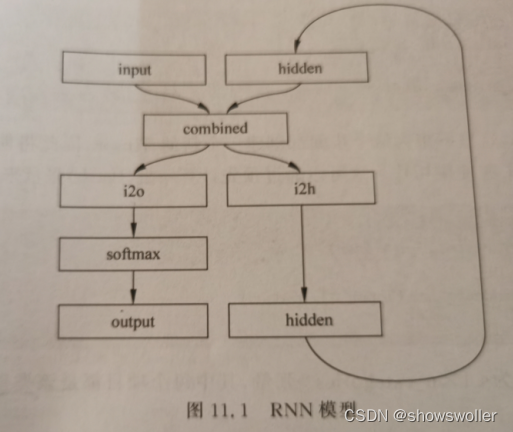
四、训练RNN网络
训练该网络所需要做的是向他输入大量的数据,令其进行预测,然后告诉它是否有错误
每个训练的循环包含下面七个步骤
1:创建输入和目标Tensor
2:创建归零的初始Hidden State
3:输入一个字母
4:传递Hidden State给下一个字母输入
5:比较最终输出和目标
6:反向传播
7:返回输出和损失
平均损失如下
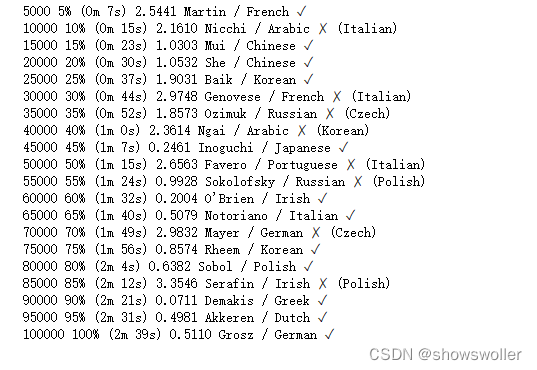
五、绘制损失变化图像
绘制网络的历史损失变化,以显示网络学习情况
可见随着训练次数的增加损失逐渐 梯度下降
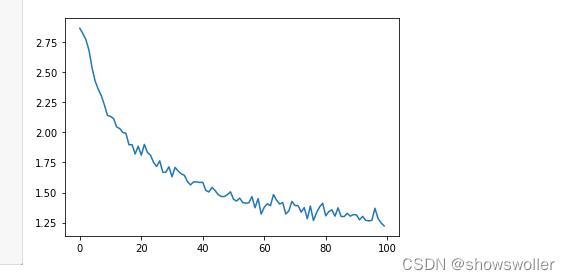
六、预测结果
为了了解网络在不同类别上的表现如何,这里将创建一个混淆矩阵,为每种实际语言指示网络猜测那种语言,结果如下图,可以从主轴上挑出一些亮点,以显示它猜错了哪些语言
可见中文/朝鲜语 西班牙语/意大利语会有混淆,网络预测希腊语名字十分准确,但是英语名字预测的很糟糕
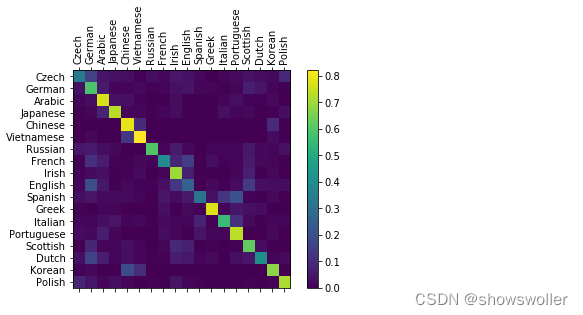
七、预测用户输入
大家可以输入任何希望预测的名字到模型中,网络会给出几个名字最有可能的语言类型
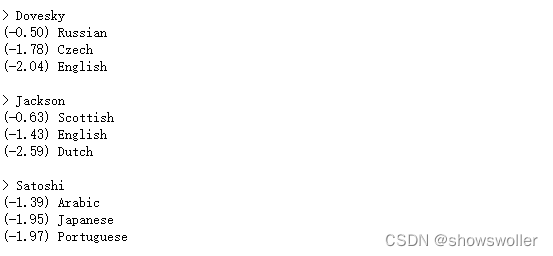
八、代码
需要全部源码请点赞关注收藏后评论区留言~~~
from __future__ import unicode_literals, print_function, divisionfrom io import open
import glob
import osdef findFiles(path): return glob.glob(path)print(findFiles('data/names/*.txt'))import unicodedata
import stringall_letters = string.ascii_letters + " .,;'"
n_letters = len(all_letters)# Turn a Unicode string to plain ASCII, thanks to https://stackoverflow.com/a/518232/2809427
def unicodeToAscii(s):return ''.join(c for c in unicodedata.normalize('NFD', s)if unicodedata.category(c) != 'Mn'and c in all_letters)print(unicodeToAscii('Ślusàrski'))# Build the category_lines dictionary, a list of names per language
category_lines = {}
all_categories = []# Read a file and split into lines
def readLines(filename):lines = open(filename, encoding='utf-8').read().strip().split('\n')return [unicodeToAscii(line) for line in lines]for filename in findFiles('data/names/*.txt'):category = os.path.splitext(os.path.basename(filename))[0]all_categories.append(category)lines = readLines(filename)category_lines[category] = linesn_categories = len(all_categories)#
# # In[33]:#print(category_lines['Italian'][:5])# Turning Names into Tensors# # In[34]:import torch# Find letter index from all_letters, e.g. "a" = 0
def letterToIndex(letter):return all_letters.find(letter)# Just for demonstration, turn a letter into a <1 x n_letters> Tensor
def letterToTensor(letter):tensor = torch.zeros(1, n_letters)tensor[0][letterToIndex(letter)] = 1return tensor# Turn a line into a ,
# or an array of one-hot letter vectors
def lineToTensor(line):tensor = torch.zeros(len(line), 1, n_letters)for li, letter in enumerate(line):tensor[li][0][letterToIndex(letter)] = 1return tensorprint(letterToTensor('J'))print(lineToTensor('Jones').size())# This RNN module (mostly copied from `the PyTorch for Torch users
# tutorial `__)
# is just 2 linear layers which operate on an input and hidden state, with
# a LogSoftmax layer after the output.
#
# .. figure:: https://i.imgur.com/Z2xbySO.png
# :alt:
#
#
#
# # In[35]:iself.i2h = nn.Linear(input_size + hidden_size, hidden_size)self.i2o = nn.Linear(input_size + hidden_size, output_size)self.softmax = nn.LogSoftmax(dim=1)def forward(self, input, hidden):combined = torch.cat((input, hidden), 1)hidden = self.i2h(combined)output = self.i2o(combined)output = self.softmax(output)return output, hiddendef initHidden(self):return torch.zeros(1, self.hidden_size)n_hidden = 128
rnn = RNN(n_letters, n_hidden, n_categories)# To run a step of this network we need to pass an input (in our case, the
# Tensor for the current letter) and a previous hidden state (which we
# initialize as zeros at first). We'll get back the output (probability of
# each language) and a next hidden state (which we keep for the next
# step).
#
#
# # In[36]:inp# For the sake of efficiency we don't want to be creating a new Tensor for
# every step, so we will use ``lineToTensor`` instead of
# ``letterToTensor`` and use slices. This could be further optimized by
# pre-computing batches of Tensors.
#
#
# # In[37]:input = lineToTensor('Albert')
hidden = torch.zeros(1, n_hidden)output, next_hidden = rnn(input[0], hidden)
print(output)# As you can see the output is a ``<1 x n_categories>`` Tensor, where
# every item is the likelihood of that category (higher is more likely).
#
#
# # Training
# ========
# Preparing for Training
# ----------------------
#
# Before going into training we should make a few helper functions. The
# first is to interpret the output of the network, which we know to be a
# likelihood of each category. We can use ``Tensor.topk`` to get the index
# of the greatest value:
#
#
# # In[38]:def categoryFromOutput(output):top_n, top_i = output.topk(1)category_i = top_i[0].item()return all_categories[category_i], category_i#print(categoryFromOutput(output))# We will also want a quick way to get a training example (a name and its
# language):
#
#
# # In[39]:import randomdef randomChoice(l):return l[random.randint(0, len(l) - 1)]def randomTrainingExample():category = randomChoice(all_categories)line = randomChoice(category_lines[category])category_tensor = torch.tensor([all_categories.index(category)], dtype=torch.long)line_tensor = lineToTensor(line)return category, line, category_tensor, line_tensorfor i in range(10):category, line, category_tensor, line_tensor = randomTrainingExample()print('category =', category, '/ line =', line)# Training the Network
# --------------------
#
# Now all it takes to train this network is show it a bunch of examples,
# have it make guesses, and tell it if it's wrong.
#
# For the loss function ``nn.NLLLoss`` is appropriate, since the last
# layer of the RNN is ``nn.LogSoftmax``.
#
#
# # In[40]:criterion = nn.NLLLoss()#
# - Keep hidden state for next letter
#
# - Compare final output to target
# - Back-propagate
# - Return the output and loss
#
#
# # In[41]:learning_rate = 0.005 # If you set this too high, it might explode. If too low, it might not learndef train(category_tensor, line_tensor):hidden = rnn.initHidden()rnn.zero_grad()for i in range(line_tensor.size()[0]):output, hidden = rnn(line_tensor[i], hidden)loss = criterion(output, category_tensor)loss.backward()# Add parameters' gradients to their values, multiplied by learning ratefor p in rnn.parameters():p.data.add_(p.grad.data, alpha=-learning_rate)return output, loss.item()# Now we just have to run that with a bunch of examples. Since the
# ``train`` function returns both the output and loss we can print its
# guesses and also keep track of loss for plotting. Since there are 1000s
# of examples we print only every ``print_every`` examples, and take an
# average of the loss.
#
#
# m = math.floor(s / 60)s -= m * 60return '%dm %ds' % (m, s)start = time.time()for iter in range(1, n_iters + 1):category, line, category_tensor, line_tensor = randomTrainingExample()output, loss = train(category_tensor, line_tensor)current_loss += loss# Print iter number, loss, name and guessif iter % print_every == 0:guess, guess_i = categoryFromOutput(output)correct = '✓' if guess == category else '✗ (%s)' % categoryprint('%d %d%% (%s) %.4f %s / %s %s' % (iter, iter / n_iters * 100, timeSince(start), loss, line, guess, correct))# Add current loss avg to list of lossesif iter % plot_every == 0:all_losses.append(current_loss / plot_every)current_loss = 0# Plotting the Results
# --------------------
#
# Plotting the historical loss from ``all_losses`` shows the network
# learning:
#
#
# # In[22]:plt.figure()
plt.plot(all_losses)# Evaluating the Results
# ======================
#
# To see how well the network performs on different categories, we will
# create a confusion matrix, indicating for every actual language (rows)
# which language the network guesses (columns). To calculate the confusion
# matrix a bunch of samples are run through the network with
# ``evaluate()``, which is the same as ``train()`` minus the backprop.
#
#
# # In[46]:# Keep track of correct guesses in a confusion matrix
confusion = torch.zeros(n_categories, n_categories)
n_confusion = 10000# Just return an output given a line
def evaluate(line_tensor):hidde
# Go through a bunch of examples and record which are correctly guessed
for i in range(n_confusion):category, line, category_tensor, line_tensor = randomTrainingExample()output = evaluate(line_tensor)guess, guess_i = categoryFromOutput(output)category_i = all_categories.index(category)confusion[category_i][guess_i] += 1# Normalize by dividing every row by its sum
for i in range(n_categories):confusion[i] = confusion[i] / confusion[i].sum()# Set up plot
fig = plt.figure()
ax = fig.add_subplot(111)
cax = ax.matshow(confusion.numpy())
fig.colorbar(cax)# Set up axes
ax.set_xticklabels([''] + all_categories, rotation=90)
ax.set_yticklabels([''] + all_categories)# Force label at every tick
ax.xaxis.set_major_locator(ticker.MultipleLocator(1))
ax.yaxis.set_major_locator(ticker.MultipleLocator(1))# You can pick out bright spots off the main axis that show which
# languages it guesses incorrectly, e.g. Chinese for Korean, and Spanish
# for Italian. It seems to do very well with Greek, and very poorly with
# English (perhaps because of overlap with other languages).
#
#
# # Running on User Input
# ---------------------
#
#
# # In[47]:def predict(input_line, n_predictions=3):print('\n> %s' % input_line)with t evaluate(lineToTensor(input_line))= []for i in range(n_predictions):value = topv[0][i].item()category_index = topi[0][i].item()print('(%.2f) %s' % (value, all_categories[category_index]))predictions.append([value, all_categories[category_index]])predict('Dovesky')
predict('Jackson')
predict('Satoshi')# The final versions of the scripts `in the Practical PyTorch
# repo `__
# split the above code into a few files:
#
# - ``data.py`` (loads files)
# - ``model.py`` (defines the RNN)
# - ``train.py`` (runs training)
# - ``predict.py`` (runs ``predict()`` with command line arguments)
# - ``server.py`` (serve prediction as a JSON API with bottle.py)
#
# Run ``train.py`` to train and save the network.
#
# Run ``predict.py`` with a name to view predictions:
#
# ::
#
# $ python predict.py Hazaki
# (-0.42) Japanese
# (-1.39) Polish
irst name -> gender
# - Character name -> writer
# - Page title -> blog or subreddit
#
# - Get better results with a bigger and/or better shaped network
#
# - Add more linear layers
# - Try the ``nn.LSTM`` and ``nn.GRU`` layers
# - Combine multiple of these RNNs as a higher level network
#
#
#
创作不易 觉得有帮助请点赞关注收藏~~~
相关内容
热门资讯
喜欢穿一身黑的男生性格(喜欢穿...
今天百科达人给各位分享喜欢穿一身黑的男生性格的知识,其中也会对喜欢穿一身黑衣服的男人人好相处吗进行解...
网络用语zl是什么意思(zl是...
今天给各位分享网络用语zl是什么意思的知识,其中也会对zl是啥意思是什么网络用语进行解释,如果能碰巧...
发春是什么意思(思春和发春是什...
本篇文章极速百科给大家谈谈发春是什么意思,以及思春和发春是什么意思对应的知识点,希望对各位有所帮助,...
为什么酷狗音乐自己唱的歌不能下...
本篇文章极速百科小编给大家谈谈为什么酷狗音乐自己唱的歌不能下载到本地?,以及为什么酷狗下载的歌曲不是...
苏州离哪个飞机场近(苏州离哪个...
本篇文章极速百科小编给大家谈谈苏州离哪个飞机场近,以及苏州离哪个飞机场近点对应的知识点,希望对各位有...
家里可以做假山养金鱼吗(假山能...
今天百科达人给各位分享家里可以做假山养金鱼吗的知识,其中也会对假山能放鱼缸里吗进行解释,如果能碰巧解...
华为下载未安装的文件去哪找(华...
今天百科达人给各位分享华为下载未安装的文件去哪找的知识,其中也会对华为下载未安装的文件去哪找到进行解...
四分五裂是什么生肖什么动物(四...
本篇文章极速百科小编给大家谈谈四分五裂是什么生肖什么动物,以及四分五裂打一生肖是什么对应的知识点,希...
怎么往应用助手里添加应用(应用...
今天百科达人给各位分享怎么往应用助手里添加应用的知识,其中也会对应用助手怎么添加微信进行解释,如果能...
客厅放八骏马摆件可以吗(家里摆...
今天给各位分享客厅放八骏马摆件可以吗的知识,其中也会对家里摆八骏马摆件好吗进行解释,如果能碰巧解决你...